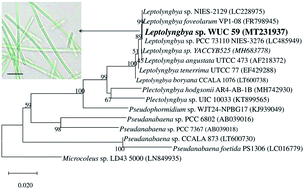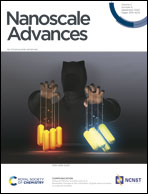Biogenic synthesis of silver nanoparticles using cyanobacterium Leptolyngbya sp. WUC 59 cell-free extract and their effects on bacterial growth and seed germination
Abstract
The biogenic synthesis of metal nanoparticles (NPs) is of great significance, as it renders clean, biocompatible, innocuous and worthwhile production. Here, we present a clean and sustainable route for the synthesis of silver nanoparticles (Ag NPs) using the cell-free aqueous extract of the cyanobacterium Leptolyngbya sp. WUC 59, isolated from polluted water and identified using a polyphasic approach. The conformation and characterisation of the as-synthesized biogenic Ag NPs was carried out using various sophisticated techniques like UV-visible (UV-Vis), X-ray diffraction (XRD), Fourier transform infrared (FTIR), energy dispersive X-ray spectroscopy (EDS) and high-resolution transmission electron microscopy (HRTEM). The sharp colour change and emergence of a characteristic peak at 430 nm in the UV-Vis spectrum confirm the formation of the Ag NPs. The morphological and physical appearance indicated that the synthesized Ag NPs are crystalline with a typical size of 20–35 nm. Furthermore, the bio-reduced nanoparticles were explored for their antibacterial activity against Bacillus subtilis and Escherichia coli bacteria, seed germination effects and early seedling growth of wheat (Triticum aestivum L.). The Ag NPs significantly suppressed the growth of both Bacillus subtilis and Escherichia coli bacteria with the treatment of 10 mg L−1 concentration within the initial 3 hours. The lower concentration (25 mg L−1) of the synthesized Ag NPs significantly enhanced the seed germination and early seedling growth of wheat in comparison to the control on the 4th and 8th day. The present investigations show that the use of the cyanobacterium Leptolyngbya sp. WUC 59 provides a simple, cost-effective and eco-friendly tool for the synthesis of Ag NPs. Moreover, it could have great potential for use as an alternative to chemical-based bactericides not only in pharmaceutical industries, but also to control bacterial diseases in agricultural crops.



 Please wait while we load your content...
Please wait while we load your content...